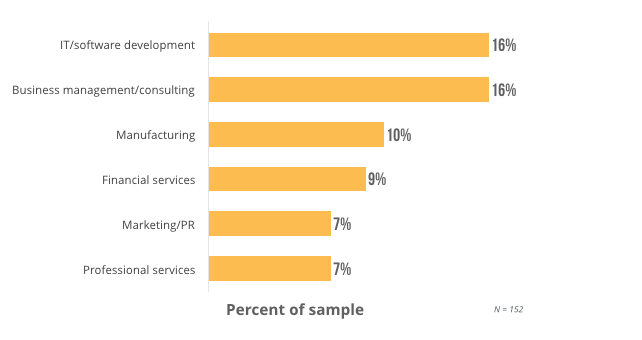Agile Trends Impacting Project Teams at Small Businesses
Over the past few years, we’ve seen a growing interest in agile project management (PM) among the small and midsize businesses (SMBs) that call our software advisors for help selecting PM software.
As SMBs increasingly adopt agile PM to help them keep pace with the changes brought on by digitization, vendors are increasingly releasing solutions tailored to meet the needs of agile teams.
To help prospective buyers evaluate the growing number of tools and make a more informed purchase decision, we surveyed SMBs to find out what agile trends are driving the industry.
We looked at the challenges your peers face and how they’re using PM software to improve operations.
Here are the agile trends we’ll cover:
Agile Project Teams Use a Combination of Tools
Agile Teams Use PM Software to Automate Reporting
Task Boards Are The Most Commonly Used Tool
Training New Users Remains a Challenge
This report is an update on our 2015 Agile Project Management Software User Report. However, in this year’s report, we looked specifically at agile trends among small and midsize businesses—those with $100 million or less in annual revenue. See demographics at the end for a breakdown of the individuals sampled for this report, including their industry and chosen framework for implementing agile.
Agile Project Teams Use a Combination of Tools
When looking at the sample as a whole, the most common tool used by small businesses to manage projects is spreadsheet software, e.g., Microsoft Excel or Google Sheets.
However, when we filter the data and look specifically at the tools used by agile teams (as opposed to both traditional and agile teams), the number of PM software users rises by nearly 10 percent.
While spreadsheets remain a critical tool for small businesses as a whole, agile teams are adopting PM software earlier than their waterfall counterparts.
Here’s why: The core principles of agile PM emphasize collaboration, continuous improvement and recognizing and embracing change. PM software helps support agile teams in their pursuit of these principles. It creates a centralized workspace wherein teams share an understanding of a project’s goals, progress and metrics for measuring success.
The centralized workspace is critical for fostering collaboration among users. Additionally, project progress is highly visible, allowing teams to reflect, adapt and change so as to continuously improve their delivery of project objectives.
Current PM Method: All Respondents vs. Agile Respondents
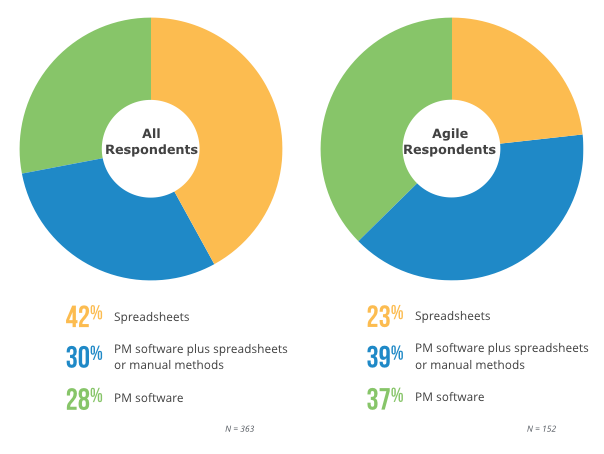
KEY TAKEAWAY:
If you’re using a combination of methods to manage projects, i.e., PM software and spreadsheets, don’t feel pressured to find an all-encompassing tool and get rid of everything else. They key is to manage projects effectively, using whatever tools work best for you.
If you’re currently using spreadsheets, but looking for PM software for your agile team, discuss your data import and export needs with vendors to ensure you’ll be able to transfer data easily between each tool.
Agile Teams Use PM Software to Automate Reporting
Now that we know agile teams are using PM software in greater frequency than their waterfall counterparts, exactly what are they using it for?
The most common operation agile teams automate using PM software is reporting, cited by 52 percent of respondents. Specifically, these teams say they use reports most often to review individual/user productivity and monitor team performance.
Agile teams also use automated tools to streamline risk identification, keep everyone on the same page for their daily scrum/stand up meeting and release planning, as well as to help map and track workflows.
PM software offers the transparency required for these operations and acts as a single repository housing all project documentation and surrounding communication. This means that anyone new to the project has access to the same information as someone who has been involved in the day-to-day activities from the beginning.
This shared understanding of a project’s risks, workflows and progress toward achieving milestones allows agile teams to work toward continuous improvement.
PM Operations Agile Teams Use PM Software to Perform
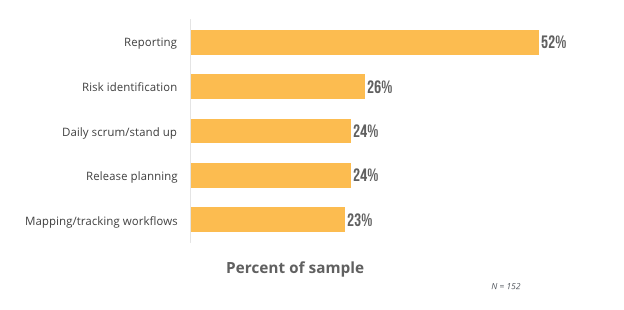
Types of Reports Used by Agile Teams
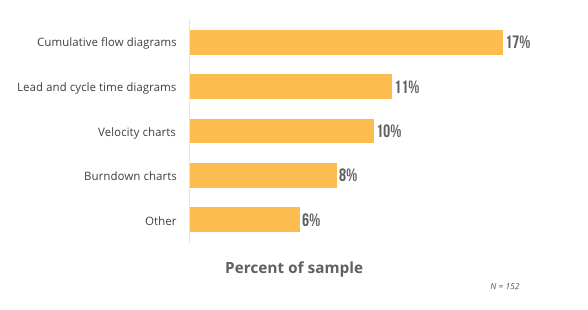
KEY TAKEAWAY:
If you’re considering a new PM solution for your agile team, look for tools that offer the types of reports that align with your team’s workflows (e.g., cumulative flow diagrams for kanban teams or velocity charts for scrum teams).
Additionally, consider the other PM operations you’ll automate using the tool: Will you need to identify and track risks? Or do you need it to serve as a backdrop for your daily scrum/standup?
Task Boards Are The Most Commonly Used Tool
The most common PM software feature used by agile teams are scrum/kanban task boards*. (See “demographics” at the end for a breakdown of the respondents implementing agile within each of these frameworks).
Task boards are an important agile tool as they help teams track their work visually. They are often used as the backdrop for a team’s daily scrum/standup meeting, because they provide status updates a glance:
Teams know what tasks are currently in progress on the board
What stage in their workflow the task came from and where it needs to go next
Whether or not they are on target to complete their tasks within the allotted time
Additional PM software features agile teams use with great frequency include file attachments, automatic notifications/alerts, activity streams and work-in-progress (WIP) limits.
Top PM Software Capabilities Used by Agile Teams
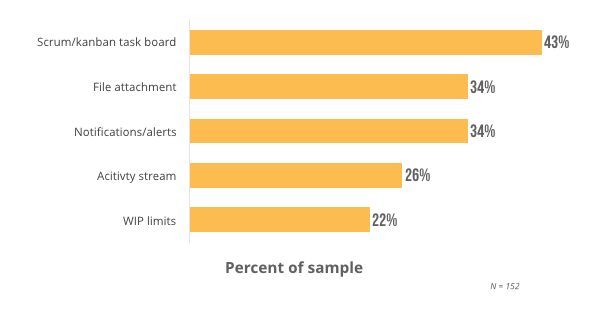
KEY TAKEAWAY:
Task boards and activity streams were also cited by users in our 2015 report on agile PM trends as tools critical to their workflows. This indicates that these features in particular are valuable for agile teams, and as such prospective PM software buyers should look for tools with these capabilities that align with their chosen agile process, e.g., either scrum or kanban.
*”Spreadsheets” were cited by 48 percent of respondents, but as those were already accounted for in the first section, we did not include them here. Similarly, when combined, “reports” were cited by 52 percent of respondents, but as those were accounted for in the second section, we did not include them here.
Training New Users Remains a Challenge
The top challenge in our 2015 report on agile PM software user trends was “difficulty training new users,” and this continues to be the main source of dissatisfaction for this year’s respondents.
This issue speaks to the greater challenge of implementing and scaling agile practices, rather than inherent difficulties in the tools themselves. As our 2015 report mentions, all PM software (not just agile tools) require training, which can prove difficult at times.
What is unique to agile teams and the tools they use is that implementing this PM methodology requires a shift in both mindset and practice. This is a shift that many organizations struggle with.
Especially since the majority of SMBs are using a hybrid approach to implement agile rather than a “pure” agile process, it makes sense that training new users would be a sticking point.
Hybrid organizations have more tools in play, and each requires time and effort to get users up to speed. Not only does training need to occur when tools are first introduced, but it should continue over the life of the tool so as to identify and close learning gaps among users.
If an organization’s philosophy or culture are at odds with agile values, or if they lack management support, it can be hard to find the resources needed to meet this training requirement.
Agile Teams’ Most Common Challenges With PM Tools
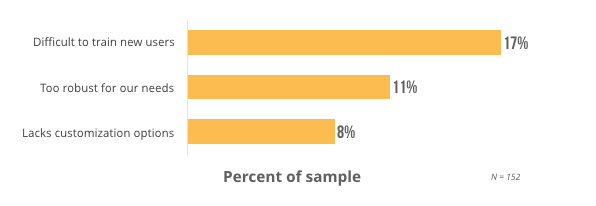
KEY TAKEAWAY:
Training new users on PM tools is a key challenge for agile teams. As we know, if users don’t receive proper training on how to use a tool, they might not adopt the tool into their workflows. For tips on how to encourage and sustain user adoption, head over to this article, where we outline several training initiatives you can employ to help facilitate user adoption.
Conclusions
The agile trends cited in this report can help guide your SMB to a more informed purchase decision. To recap:
If you’re currently using spreadsheets to manage projects, bear this in mind when evaluating products. Don’t feel pressured to throw out your current workflows, and instead ask vendors how their products accommodate your needs and existing tools.
Look for PM software with reporting capabilities that align with your team’s workflows, e.g., kanban or scrum. Many tools will offer both types of task boards as well as reporting options, but don’t assume that every product will.
Agile teams use a variety of PM software features, some that are obviously “agile,” e.g., scrum/kanban task boards, and some that aren’t so obvious, e.g., file attachments and automatic notifications/alerts. It’s important to remember this when evaluating tools so that in the face of all the agile features you may not be used to, you don’t forget to ask vendors about file size limitations for attachments or the ability to set an alert for an impending deadline.
Training can make or break a software implementation, so take note that this has been the most common challenge cited by agile teams in both our 2015 and 2017 reports. There are various steps you can take before you buy, during the selection process and after implementation to help encourage and sustain user adoption. Follow our roadmap for the best chance at a successful PM software implementation.
For more information about the PM tools available for agile teams, email me at eileen@softwareadvice.com. I’m available to answer any questions you may have, and when you’re ready, can help get you set up with a price quote or product demo.
Demographics
The demographics for the survey respondents cited in this report are as follows:
SMBs split nearly 60/40 between traditional, i.e., waterfall, and agile project teams
Hybrid agile more common at small businesses than a “pure” agile implementation
The top industries for SMB agile teams are IT/software development (16 percent) and business management/consulting (16 percent)
Respondents by Project Management Method
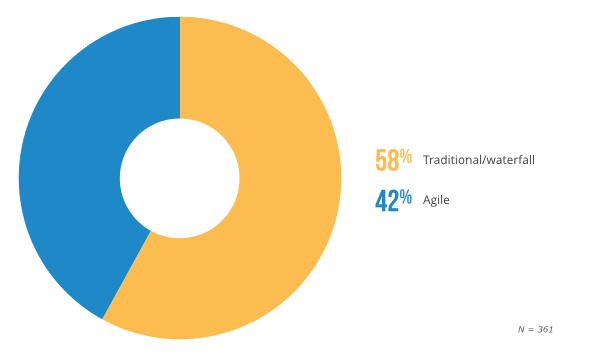
Agile Respondents by Agile PM Framework
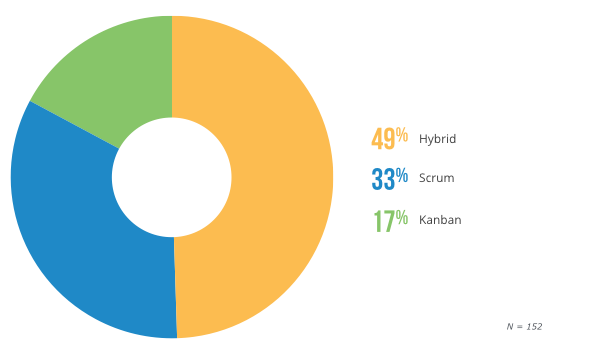
Agile Respondents by Industry
